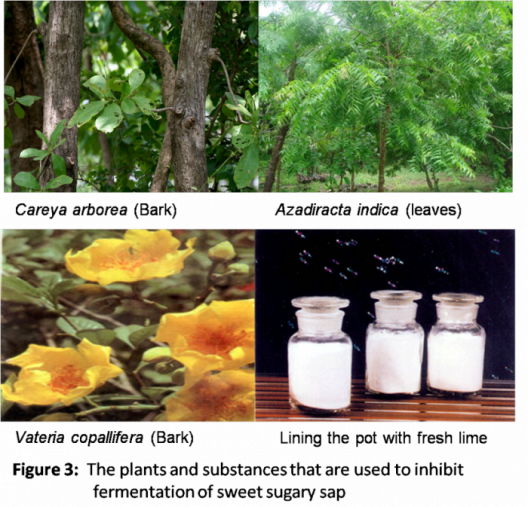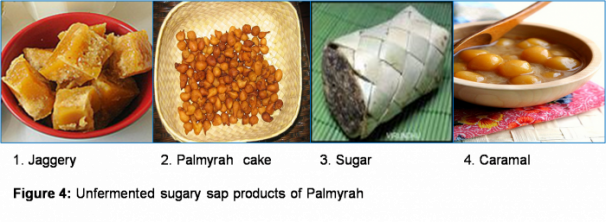Background
Figure 2: Inflorescence of a palmyrah tree is tapped and the sap is collected in pots lined with lime.
The main source of crude sugar in SriLanka is the sweet sugary sap obtained from the tapped inflorescence of the Coconut (Cocos nucifera), Palmyrah (Borassus flabellifer) and Kithul (Caryota urens) palms. This sap is free of fermentation, sterile and highly charged with sugar, but unless special precautions are taken, fermentation by yeast and bacteria leads to accumulation of alcohol and acids (Ariyasena et al 1999).
If fermentation is arrested then the palmyrah sap could be processed to produce juggery, sugar, caramal and other food and beverages. Several methods are practiced in SriLanka to prevent such fermentation taking place in the sap (Theivendirarajah, K. 1992). Lining the inside of the pot with fresh lime, placing the barks of Vateria copallifera and Careya arborea and placing the leaves of Azadiracta in a clean pot before it is used for collecting sap, are the most common methods used to reduce fermentation, in SriLanka.
Though the usage of such substances reduce considerable amount of fermentation, they might change the original taste of the sweet toddy and the jaggery to a great extent. This results in poor consumer affinity towards sweet toddy products (Jansz et al, 1994). Thus the effective substance is needed to inhibit fermentation taking place in sweet sugary saps of palm trees in order to get the sweet toddy with the original taste.
The objective of the study
It is to study the effect of various substances used in SriLanka, to prevent fermentation taking place in the palmyrah sap and to recommend the cheapest and easily available substance, which prevents fermentation efficiently.
If fermentation is arrested then the palmyrah sap could be processed to produce juggery, sugar, caramal and other food and beverages. Several methods are practiced in SriLanka to prevent such fermentation taking place in the sap (Theivendirarajah, K. 1992). Lining the inside of the pot with fresh lime, placing the barks of Vateria copallifera and Careya arborea and placing the leaves of Azadiracta in a clean pot before it is used for collecting sap, are the most common methods used to reduce fermentation, in SriLanka.
Though the usage of such substances reduce considerable amount of fermentation, they might change the original taste of the sweet toddy and the jaggery to a great extent. This results in poor consumer affinity towards sweet toddy products (Jansz et al, 1994). Thus the effective substance is needed to inhibit fermentation taking place in sweet sugary saps of palm trees in order to get the sweet toddy with the original taste.
The objective of the study
It is to study the effect of various substances used in SriLanka, to prevent fermentation taking place in the palmyrah sap and to recommend the cheapest and easily available substance, which prevents fermentation efficiently.



